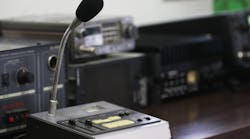Communications technology has gone through dramatic change over the past 40 years, as has most of electronics technology. Vacuum tubes were eventually replaced by solid-state transistors, and those discrete semiconductors have largely been replaced by integrated circuits, as an increasing number of electronic functions continue to be compressed into smaller circuit and package sizes.
Dr. Ulrich Rohde—chairman of Synergy Microwave Corp., and author of numerous texts on high-frequency-electronics topics ranging from circuits to systems—has teamed with fellow authors Jerry Whitaker and Hans Zahnd to address a plethora of design issues related to modern communications receiver technologies. The 4th edition of their text Communications Receivers—Principles and Design (McGraw-Hill Education) is now available.
Suitable for use as a reference source, the book’s 11 chapters explore both analog and digital receivers and their components, with special attention paid to the programmable software-defined radios (SDRs) that have become a popular architecture for commercial and military communications applications. The book includes in-depth studies of many of the components that are essential to communications receiver operation, including antennas, frequency mixers, and signal sources such as oscillators and frequency synthesizers.
At 685 pages, this is not a quick read. But for any engineer serious about learning more about both analog and digital receiver architectures, this is an invaluable information source that will be referred to often.
The book draws heavily from Rohde’s passion for and experience with amateur (ham) radios. A number of design examples use block diagrams for two-way radios and portions of the bibliography for early, introductory chapters, noting sources such as the ARRL Handbook for Radio Communications and Ham Radio magazine. Of course, more often, Rohde’s reference material stems from such sources as the Bell System Technical Journal and IEEE Transactions on Microwave Theory & Techniques, and the quality and accuracy of the written material reflects such sources.
One of the more practical block diagrams, in chapter 3, of a high-frequency (HF) receiver, is accompanied by a partial level diagram. The diagram shows noise figures, gains, and intercept points for each stage of the receiver front end for different operating conditions, for a better understanding on how the receiver as well as its front-end components, such as local oscillators (LOs), mixers, and filters, perform under these conditions.
While Communications Receivers pays proper respect to analog receiver designs, it is an ambitious effort to cover digital receivers such as SDRs and the signal-processing components, such as analog-to-digital converters (ADCs), digital-to-analog converters (DACs), digital signal processors (DSPs), and field-programmable gate arrays (FPGAs), that are so essential to those digital receivers. The text provides simplified explanation of the different functions of these components, but goes into more detail on how the component-level performance of each device relates to system-level performance, such as receiver dynamic range and noise figure.
The text provides a healthy (but not overwhelming) dose of equations, as needed to explain such calculations as noise figure and dynamic range, and even error rates for digital systems. It is generously illustrated with system-level block diagrams and performance plots from commercial test receivers to display various receiver parameters, such as intercept points and spurious noise levels.
Admittedly, it is quite ambitious, in attempting to review different types of components, such as filters, antennas, mixers, and signal sources. Still, it is a comprehensive single source that contains an enormous amount of information on communications receivers—more on the digital side than on analog architectures—and is a text that every system-level engineer will want in their collection.

